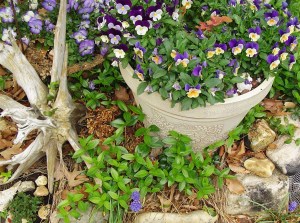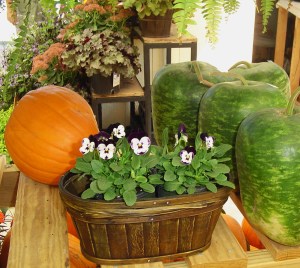 Violas are finally here, ready to plant in our pots and beds to enjoy all winter. Even as we watch weather reports of 20+ inches of snow falling in early winter storm Atlas over six states in the upper mid-west of the US, I’m planning our winter flower garden.
Violas are finally here, ready to plant in our pots and beds to enjoy all winter. Even as we watch weather reports of 20+ inches of snow falling in early winter storm Atlas over six states in the upper mid-west of the US, I’m planning our winter flower garden.
Violas, a huge genus of between 500 and 600 species, love cool weather. The perennial Viola odorata is a naturalized wildflower in our garden. These small, edible flowers begin blooming in early spring and continue until the weather warms. These are different from the Viola cultivars showing up in garden centers now.

Violas purchased in a six pack cost less than fifty cents per plant. An excellent invest in winter color!
Sometimes called pansies, Viola cultivars bring welcome color to winter days. Pansies are the large flowered members of this beautiful group of winter bedding plant. Violas, the smaller flowered selections; and Panolas, new in-between hybrids; are somewhat tougher and more cold hardy. While pansies may take a break during the coldest weeks of winter, Panolas and Violas, sometimes known as “Johnny Jump-Ups,” keep blooming all winter long in Zone 7.
It is possible to have flowers blooming 365 days each year by planting Violas in autumn. They make for beautiful combinations in pots, planted with Heuchera, ferns, kales and cabbages, shrubs, mosses, and late flowering perennials. Underplant the Violas with various spring flowering bulbs, and the show continues through late winter and into early summer with flowers coming and going continuously.
Violas can also be used as edging around flower beds and borders. They keep the bed alive and attractive throughout the fall and winter. They fill in nicely around spring bulbs, and keep the bed interesting after the bulbs fade.

Panolas are a fairly new hybrid,. They combine the hardiness of the smaller Violas with the larger face and brighter colors of true pansies. These are some favorites with ruffled petals.
Violas are an excellent investment. Purchased now in six-packs, they can be had for less than fifty cents per plant. They are easy to grow, spread to cover a large area, and can be counted on for non-stop color well into May. The only thing that stops Violas is summer heat.
Sun loving in winter, the life of a Viola plant can be extended by moving it into the shade in late April or early May. I frequently move mine out of featured pots and into shaded beds in late spring. Often they drop seeds, and new plants appear over the summer. Some of these survive the summer heat; others give up in July or August. In more northern areas Violas can live happily all summer long. Many species and cultivars are perennial.
Plant Violas now in rich potting mix or amended garden soil. They grow equally well in pots or in the ground so long as they have sunshine and steady moisture. They are heavy feeders to maintain their continuous bloom. Sprinkle Osmocote over the planting. If planting in the ground, work in compost and Plant Tone as you plant, or topdress the planting with Osmocote. I also add a pea gravel mulch both to hold in moisture and keep the plants clean in the rain. Pea gravel will also to slow down the squirrels who love to dig in my pots.
Deer and rabbits will graze unprotected Violas. If you have hungry deer as we do, use Plant Skydd or another product to protect them. You might also plant garlic, chives, or onions with them, sprinkle the planting with human hair, or use another deterrent such as moth balls. In pots, near the house or on a deck, the deer are much less likely to find them. If voles are a problem in your beds, Daffodil bulbs will offer some protection as their roots are poisonous.
Joel Patton and his family share our love of Violas. It may be Joel’s favorite flower, and he plants more varieties each season than anyone else in the area. He and his family grow between 40 and 50 different varieties of pansy, Panola, and Viola each year, in almost any color you can imagine. The plants are grown organically, without harmful chemicals of any sort, and are cared for lovingly until adopted by the customer. Their plants are available in six packs, 4” pots, three to a 6” pot, and already planted into containers with a mix other plants.
We are never tempted to buy them early at a big box store. Homestead Garden Center keeps them protected until it is time to set them outside in the fall. Planted too early, the heat will get them. It is best to wait until October or even November to plant them out.
If you have never grown Violas, please give them a try. Although pansies are common and easy to find, the smaller Viola species give a much better show over the season. Although the flower is smaller, there are generally more blooming at any given time on a single plant. They stand up better in freezing weather, and also last a few weeks longer in the spring than pansies will.
During winter, when nature’s palette has faded to shades of brown and grey, Violas give that sparkle of bright color we all crave. Their vivid blooms brighten the coldest winter day, and remind us it is always spring, somewhere.
All photos by Woodland Gnome 2013
Related articles
- A Four Season Pot (forestgardenblog.wordpress.com)
- Spice up your Containers with ‘Cool Season Superstars’ (gardenspotnursery.wordpress.com)








Good day, Can I export your page photo and use that on my personal web site?
Thank you for asking, Agnus. I would encourage you to capture photos from your own garden. I never give photos away. Best wishes, The Woodland Gnome
Pingback: Small Beginnings | Forest Garden
I love these little flowers. Are violas the same as violets? I used to call the violets when I was a kid 🙂 Annie
Hi Annie, the violets we grew up with are Viola odorata, a species of Viola. They are an edible perennial, also used in making perfume. The annual Violas are related, but different species. The annuals begin blooming in fall, and will bloom all winter. They are still in bloom when the perennial violets bloom in early spring. I love them, too, and am so excited when they open each spring 😉
violet perfume sounds interesting 🙂
They distill the essential oil, as they do with roses. Very subltle- a very old fashioned sort of fragrance 😉
I just added a photo to the post- of a seedling which grew in the mortar in our front porch. Interesting photo, forgotten when constructing the post last night.
Pingback: Violas For Winter Blooms | Potted Plant Society
Reblogged this on Potted Plant Society.
So true so true. Oh what fun they are these little hardy pixie pansies, oops, violas!
I like little hardy pixie pansies better 😉